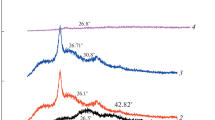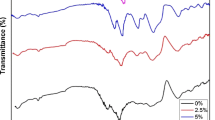Abstract
Polymer nanocomposites with vital reinforcements of conductive fillers have evinced as next-generation high-performance materials with multi-functional applications. Herein, we report the facile synthesis of thermally stable, highly electrically conducting polyaniline multi-walled carbon nanotubes (PANI/MWCNT) nanocomposites doped in two different protonic acids, i.e. hydrochloric acid (HCl) and sulphuric acid (H2SO4). The doping acids significantly affect the electric and dielectric properties of conducting polymer nanocomposites. The paper probes in the synergistic effects of MWCNTs and the effect of doping acid on the thermal stability, conductivity and dielectric properties of the nanocomposites based on PANI nanofibres. The structural, morphological, optical, thermal and electrical properties were evaluated through X-ray diffraction, scanning electron microscopy, Raman spectroscopy, Fourier transform infrared spectroscopy, UV–Vis spectroscopy, thermogravimetric analysis and two-point probe technique. Ascribed to the high interfacial interaction between PANI and MWCNT, and considering the effect of doping acids, nanocomposites with high thermal stability, enhanced conductivity and high dielectric constant that can store large electrical charges have been synthesized by surfactant-assisted, in situ oxidative polymerization of aniline, in the presence of potassium persulfate as oxidant. The micellar structure of surfactant assists the dispersion of MWCNTs as well as the formation of PANI/MWCNT tubular structures. The effect of surfactant below and above critical micelle concentration was also studied. This complete study would affirm such a nanocomposite which procures excellent electrical and dielectric properties for microelectronic applications.











Similar content being viewed by others
References
Coleman JN, Khan U, Blau WJ, Gun’ko YK (2006) Small but strong: a review of the mechanical properties of carbon nanotube–polymer composites. Carbon 44:1624–1652
Alam MM, Wang J, Guo Y, Lee SP, Tseng HR (2005) Electrolyte-gated transistors based on conducting polymer nanowire junction arrays. J Phys Chem B 109:12777–12784
Zhang X, Goux WJ, Manohar SK (2004) Synthesis of polyaniline nanofibers by “nanofiber seeding”. J Am Chem Soc 126:4502–4503
Chiou NR, Lu C, Guan J, Lee LJ, Epstein AJ (2007) Growth and alignment of polyaniline nanofibres with superhydrophobic, superhydrophilic and other properties. Nat Nanotechnol 2:354
Virji S, Kaner RB, Weiller BH (2006) Hydrogen sensors based on conductivity changes in polyaniline nanofibers. J Phys Chem B 110:22266–22270
Dang ZM, Yuan JK, Zha JW, Zhou T, Li ST, Hu GH (2012) Fundamentals, processes and applications of high-permittivity polymer–matrix composites. Prog Mater Sci 57:660–723
Yousefi N, Sun X, Lin X, Shen X, Jia J, Zhang B, Kim JK (2014) Highly aligned graphene/polymer nanocomposites with excellent dielectric properties for high performance electromagnetic interference shielding. Adv Mater 26:5480–5487
Famengo A, Ferrario A, Boldrini S, Battiston S, Fiameni S, Pagura C, Fabrizio M (2017) Polyaniline–carbon nanohorn composites as thermoelectric materials. Polym Int 66:1725–1730
Zhou K, Wang H, Jiu J, Liu J, Yan H, Suganuma K (2018) Polyaniline films with modified nanostructure for bifunctional flexible multicolor electrochromic and supercapacitor applications. Chem Eng 345:290–299
Jelmy EJ, Ramakrishnan S, Rangarajan M, Kothurkar NK (2013) Effect of different carbon fillers and dopant acids on electrical properties of polyaniline nanocomposites. Bull Mater Sci 36:37–44
Zhang L, Wan M (2002) Synthesis and characterization of self-assembled polyaniline nanotubes doped with D-10-camphorsulfonic acid. Nanotechnology 13:750
Kumar V, Yokozeki T, Goto T, Takahashi T, Sharma S, Dhakate SR, Singh BP (2018) Scavenging phenomenon and improved electrical and mechanical properties of polyaniline–divinylbenzene composite in presence of MWCNT. Int J Mech Mater Des 14:697–708
Wang Y, Liu A, Han Y, Li T, Jin T, Zhang J, Zhang J (2019) Itaconic acid-doped polyaniline/MWCNTs nanocomposites for microwave absorbing materials. High Perform Polym 31:928–934
Gu H, Zhang H, Ma C, Lyu S, Yao F, Liang C, Gu J (2017) Polyaniline assisted uniform dispersion for magnetic ultrafine barium ferrite nanorods reinforced epoxy metacomposites with tailorable negative permittivity. J Phys Chem C 121:13265–13273
Zhang Y, Wang L, Zhang J, Song P, Xiao Z, Liang C, Gu J (2019) Fabrication and investigation on the ultra-thin and flexible Ti3C2Tx/co-doped polyaniline electromagnetic interference shielding composite films. Compos Sci Technol 183:107833
Mostaani F, Moghbeli MR, Karimian H (2018) Electrical conductivity, aging behavior, and electromagnetic interference (EMI) shielding properties of polyaniline/MWCNT nanocomposites. J Thermoplast Compos Mater 31:1393–1415
Choi HJ, Park SJ, Kim ST, Jhon MS (2005) Electrorheological application of polyaniline/multi-walled carbon nanotube composites. Diam Relat Mater 14:766–769
Ma PC, Siddiqui NA, Marom G, Kim JK (2010) Dispersion and functionalization of carbon nanotubes for polymer-based nanocomposites: a review. Compos Part A Appl Sci Manuf 41:1345–1367
Vaisman L, Wagner HD, Marom G (2006) The role of surfactants in dispersion of carbon nanotubes. Adv Colloid Interface Sci 128:37–46
Strano MS, Moore VC, Miller MK, Allen MJ, Haroz EH, Kittrell C, Smalley RE (2003) The role of surfactant adsorption during ultrasonication in the dispersion of single-walled carbon nanotubes. J Nanosci Nanotechnol 3:81–86
Goyal PS, Aswal VK (2001) Micellar structure and inter-micelle interactions in micellar solutions: results of small angle neutron scattering studies. Curr Sci 80:972–979
Rahy A, Bae J, Wu A, Manohar SK, Yang DJ (2011) Nano-emulsion use for the synthesis of polyaniline nano-grains or nano-fibers. Polym Adv Technol 22:664–668
Kulkarni MV, Viswanath AK (2004) Scanning electron microscopy, spectroscopy, and thermal studies of polyaniline doped with various sulfonic acids. J Macromol Sci A 41:1173–1186
Wu TM, Lin YW (2006) Doped polyaniline/multi-walled carbon nanotube composites: preparation, characterization and properties. Polymer 47:3576–3582
Jang J, Bae J, Lee K (2005) Synthesis and characterization of polyaniline nanorods as curing agent and nanofiller for epoxy matrix composite. Polymer 46:3677–3684
Du XS, Xiao M, Meng YZ (2004) Facile synthesis of highly conductive polyaniline/graphite nanocomposites. Eur Polym J 40:1489–1493
Tchmutin IA, Ponomarenko AT, Krinichnaya EP, Kozub GI, Efimov ON (2003) Electrical properties of composites based on conjugated polymers and conductive fillers. Carbon 41:1391–1395
Zhao B, Hu H, Yu A, Perea D, Haddon RC (2005) Synthesis and characterization of water soluble single-walled carbon nanotube graft copolymers. J Am Chem Soc 127:8197–8203
Dresselhaus MS, Dresselhaus G, Saito R, Jorio A (2005) Raman spectroscopy of carbon nanotubes. Phys Rep 409:47–99
Wu TM, Lin YW, Liao CS (2005) Preparation and characterization of polyaniline/multi-walled carbon nanotube composites. Carbon 43:734–740
Salvatierra RV, Oliveira MM, Zarbin AJ (2010) One-pot synthesis and processing of transparent, conducting, and freestanding carbon nanotubes/polyaniline composite films. Chem Mater 22:5222–5234
Mostafaei A, Zolriasatein A (2012) Synthesis and characterization of conducting polyaniline nanocomposites containing ZnO nanorods. Prog Nat Sci Mater 22:273–280
Rybiński P (2017) Influence of carbon fillers on thermal properties and flammability of polymeric nanocomposites. Int Polym Proc 32:270–289
Koops CG (1951) On the dispersion of resistivity and dielectric constant of some semiconductors at audiofrequencies. Phys Rev 83:121
Maxwell JC (1973) Electricity and magnetism, vol 1. Oxford University Press, New York, p 828
Patankar KK, Dombale PD, Mathe VL, Patil SA, Patil RN (2001) AC conductivity and magnetoelectric effect in MnFe1. 8Cr0. 2O4–BaTiO3 composites. Mater Sci Eng B 87:53–58
Pinto NJ, Sinha GP, Aliev FM (1998) Frequency-dependent conductivity and dielectric permittivity of emeraldine base and weakly doped poly (o-toluidine). Synth Metal 94:199–203
Acknowledgements
SJP would also like to acknowledge DST for providing the funding under INSPIRE-Fellowship Scheme (IF 160064).
Author information
Authors and Affiliations
Corresponding author
Additional information
Publisher's Note
Springer Nature remains neutral with regard to jurisdictional claims in published maps and institutional affiliations.
Rights and permissions
About this article
Cite this article
Paul, S.J., Gupta, B.K. & Chandra, P. Probing the electrical and dielectric properties of polyaniline multi-walled carbon nanotubes nanocomposites doped in different protonic acids. Polym. Bull. 78, 5667–5683 (2021). https://doi.org/10.1007/s00289-020-03399-7
Received:
Revised:
Accepted:
Published:
Issue Date:
DOI: https://doi.org/10.1007/s00289-020-03399-7




